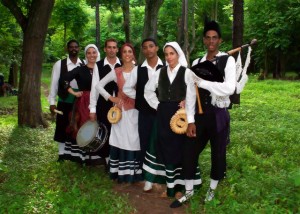Happy Dia de Asturias!
 September 8 is Asturias Day, a public holiday in the Celtic region of Northern Spain that marks the birth of Mary. It is celebrated across the Asturian Diaspora, especially in Latin America. Here is a brief overview of what many people call the 8th Celtic Nation.
September 8 is Asturias Day, a public holiday in the Celtic region of Northern Spain that marks the birth of Mary. It is celebrated across the Asturian Diaspora, especially in Latin America. Here is a brief overview of what many people call the 8th Celtic Nation.
Asturias was the last part of Spain taken by the Romans – very late, when most of Spain had already been colonized for almost 400 years. The Celtic tribes of Asturias fought the Romans for almost ten years, in the Cantabrian Wars. Rome needed more time and men to take Asturias than to take all Gaul. The reason for this conquest was that Emperor Augustus wanted to fix the limits of the Empire and needed fresh men in his legions. (The men of my city, Gijón, called themselves Cymru, like modern Wales.) Most of those Asturians the Romans enlisted were sent to Britain and Scotland, to build the Hadrian Wall, possibly because they spoke a language quite similar to that of the British Celts. Chesters Fort in the Hadrian`s Wall was kept for almost 400 years by those Asturian Cylurms compulsorily enlisted in the Roman legions. For over 400 years at the Wall Asturians and Scots must have maintained a close contact. The first were paid by Rome, but probably they felt closer to the Picts and Caledonians than to the Roman masters.
The Towers Cape was the original settlement of the Cylurms, the original inhabitants of Asturias, and remained a Celtic stronghold for almost 800 years. Cylurm was one of the key places in ancient times for the trade of bronze around the Atlantic Celtic arch. There are many villages in Asturias called Belenos, like the Irish god, or Taran, or Lug. Although deeply Romanized, about 1,000 Celtic words remain in the Asturian language spoken today, the great trace of Celtic presence may still be felt.
A marvellous Celtic site in the Asturian region, the “Campa Torres” or “The Torres Bay”, now destroyed for development, was inhabited for almost two thousand years by the Celtic people of the Cylurni. The Torres Bay was an impressive promontory jutting into the Atlantic, near to the city of Gijón, and, sadly, near to the port of Gijón. It was from here that the horse soldiers of the Ala Asturica were sent by Rome to build and defend the Hadrian Wall. The remains of these Celtic people of northern Spain can still be found in the Fort of Chesters, in Northumberland, the most important fortress guarding the Hadrian Wall. On the archaelogical site, remains of products coming from Ireland or Britanny 2.000 years ago had been found. Torres was important for the Celtic world given the abundance of zinc necessary for producing bronze. The Cylurns were famous for his ability with the bronze and copper. (In their language this meant ‘The Coppersmiths’).
In the Iron Age, the territory came under the cultural influence of the Celts; the local Celtic peoples, known as the Astures, were composed of tribes such as the Luggones, the Pesicos, and others, who populated the entire area with castros (fortified hill-towns). Today the Astur Celtic influence persists in place names, such as those of rivers and mountains. The most characteristic instrument in traditional music is the Asturian bagpipe, or gaita, which has a single drone in common with the traditional bagpipes of other Celtic nations such as Wales & Ireland.
~ Photo of Resurrectio (Pinar Del Rio) by Dervys Lorenzo Calzadilla Hernandez



















Leave a Comment